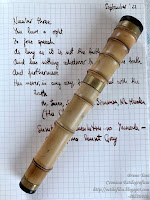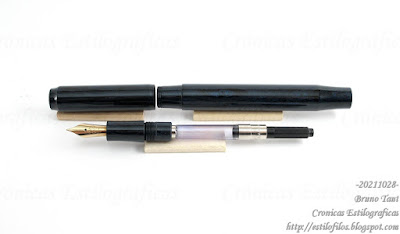One could be forgiven for thinking that not much can be said about iconic pens. After all, being iconic means that they are well-known and documented, and people even write monographs about them!
The Pilot Capless/Namiki Vanishing Point does not yet have a monograph, but sure it is an iconic pen—one of the few Japanese icons in the world of pens. So, is it mostly all known about this family of pens?
I thought so, but reality is always surprising.
The first Pilot Capless –
the C-600MW-- was marketed in 1963, and in the following years newer models were released in a trend that lasts until today. And all of them were made in Japan.
Or were they?
It looked like that until I saw a Capless made in Brazil.
 Industria Brasileira.
Industria Brasileira.
 Industria Brasileira.
Industria Brasileira.
We know Pilot created
a manufacturing plant in Brazil in 1954.
Inks and pens and other stationery products have been and are produced in there. Now, which pen models were made in Brazil? I described the
model 77, and a commentator mentioned a model 88. And, what about the Capless?
In essence, this Brazilian model is equivalent to the
C-300GW model made in Japan between 1964 and 1971, but there are some differences:
 The Japanese C-300GW. Gold nib, cartridge/converter filling.
The Japanese C-300GW. Gold nib, cartridge/converter filling.
– The Brazilian nib is made of steel.
– The Brazilian filling system is built in the nib unit and cannot be detached from it. At least, not in a trivial way. Therefore, the use of cartridges is not an option on this pen.
These differences are consistent with path other Pilot pens followed when made in
overseas plants—downgraded and simplified. Simplification in this case means not having to deal with the production and distribution of ink cartridges.
 The Brazilian box.
The Brazilian box.
As usual, this pen raises more questions than it answers:
– When was this pen made? Was it contemporary to the Japanese counterpart or was its production moved to Brazil once the Japanese pen had been discontinued?
– Was it fully made in Brazil or assembled from Japan-made parts?
– Where were this Brazilian Capless marketed?
Pilot Japan holds very few records about foreign production of pens.
And the quest for information continues.
My thanks to TM.
Mannenhitsu-no Yamada – Noodler's Apache Sunset
Bruno Taut
August 22nd, 2022
etiquetas: Pilot, Brasil, Capless












































